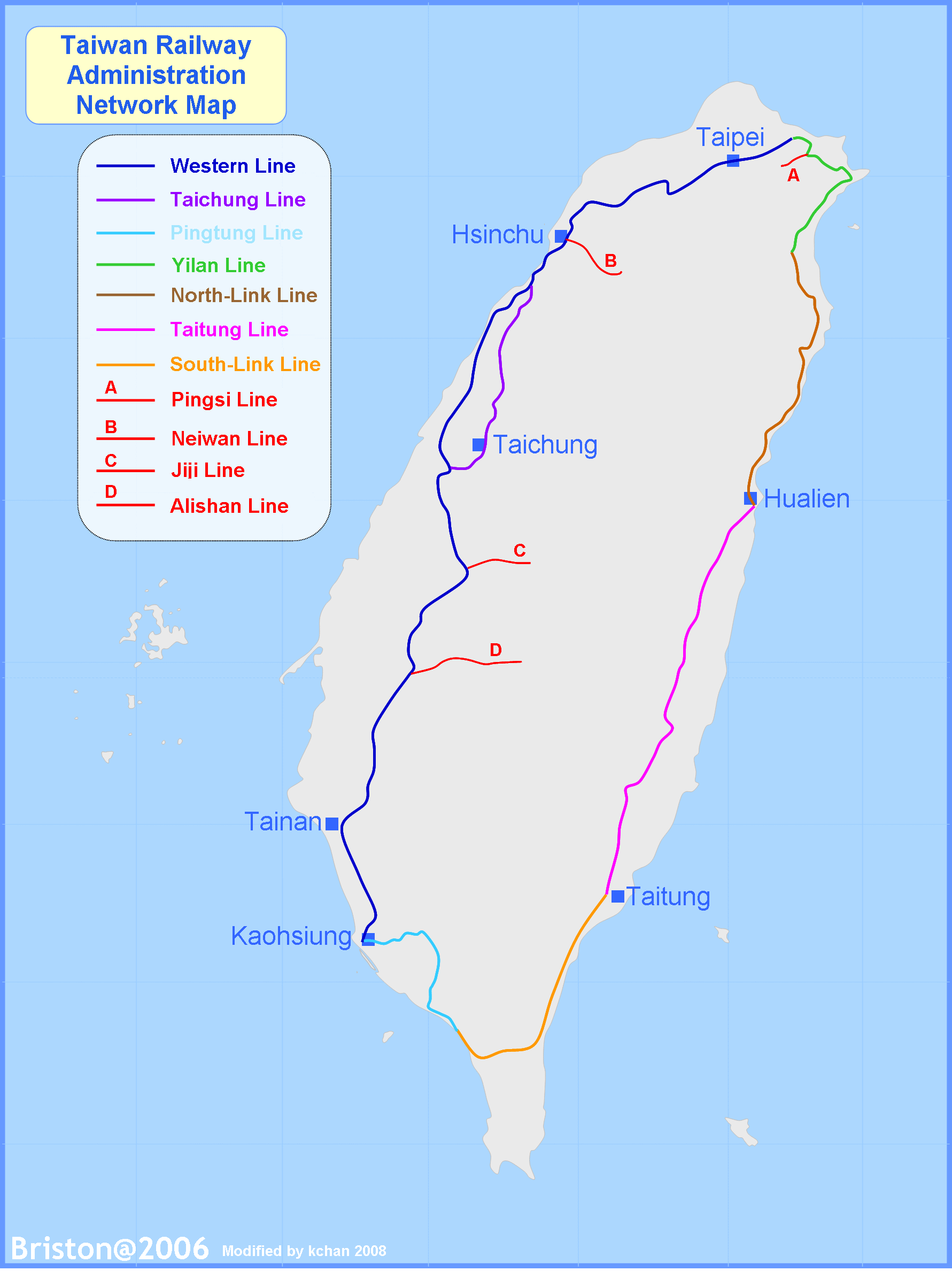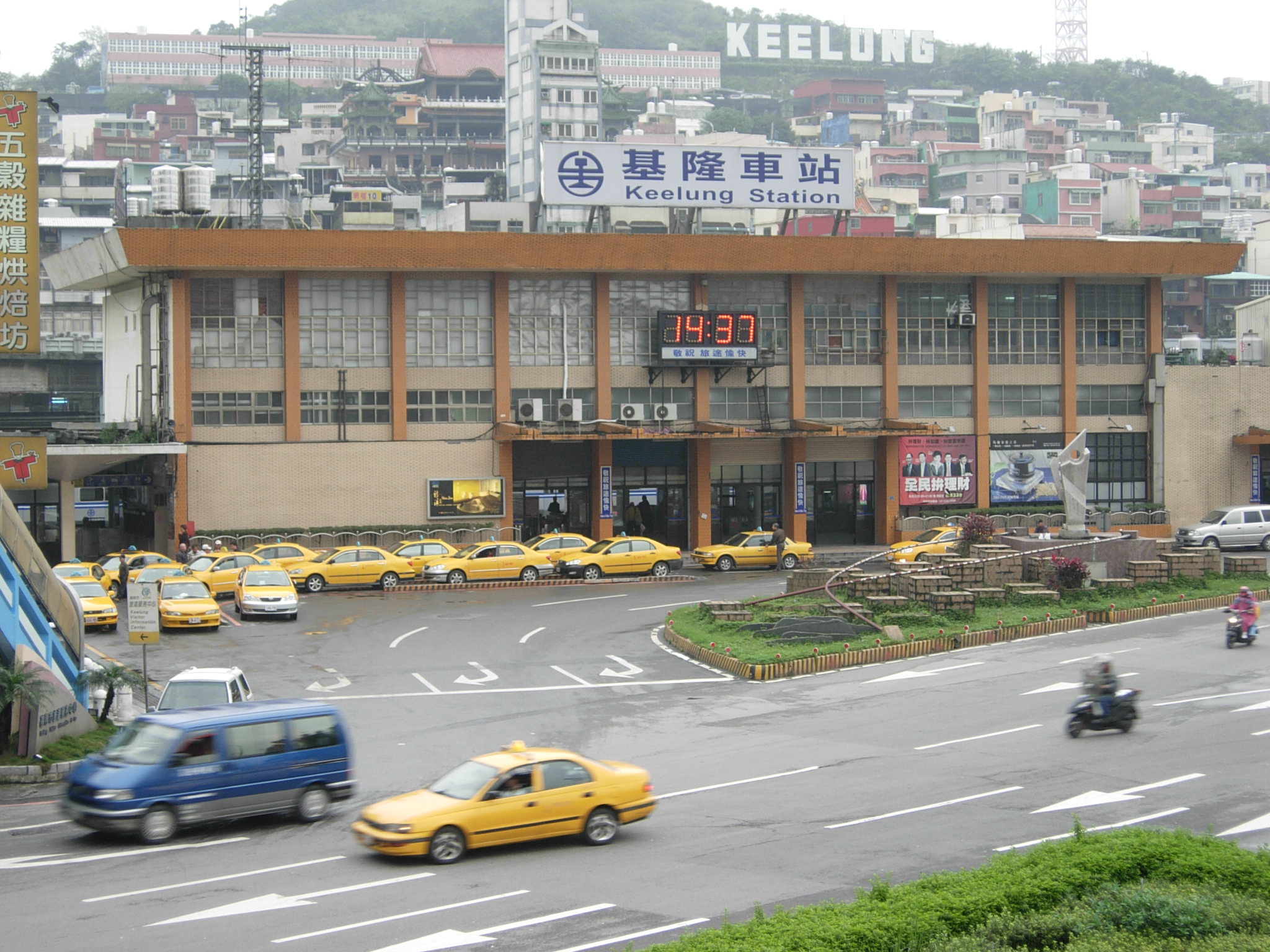|
Xiangshan Railway Station
Xiangshan railway station () is a railway station located in Xiangshan District, Hsinchu City, Taiwan. It is located on the West Coast line and is operated by Taiwan Railways. The wooden station building is a city-designated historical monument. Around the station * Haishan Fishing Port The Haishan Fishing Port () is a fish harbor in Xiangshan District, Hsinchu City, Taiwan. History In 1988, the Hsinchu City Government built tide breaker to provide a place for fishing boats to park during monsoon periods. Economy Fishermen a ... References 1902 establishments in Taiwan Railway stations opened in 1902 Railway stations in Hsinchu Railway stations served by Taiwan Railways Administration {{Taiwan-railstation-stub ... [...More Info...] [...Related Items...] OR: [Wikipedia] [Google] [Baidu] |
Taiwan Railways Administration
Taiwan Railways Administration (TRA) is a railway operator in Taiwan. It is an agency of the Ministry of Transportation and Communications, responsible for managing, maintaining, and running conventional passenger and freight railway services on 1097 km of track in Taiwan. Since Taiwan is heavily urbanised with a high population density, railways have played an important part in domestic transportation since the late 19th century. Passenger traffic in 2018 was 231,267,955. The agency's headquarters are in Zhongzheng District, Taipei. Overview Railway services between Keelung and Hsinchu began in 1891 under China's Qing dynasty. Because the railway was completely rebuilt and substantially expanded under the operated by Formosa's Japanese colonial government (1895–1945), the network's Japanese influence and heritage persists. Similarities between the TRA and the Japan Railways (JR) companies can be noted in signal aspects, signage, track layout, fare controls, sta ... [...More Info...] [...Related Items...] OR: [Wikipedia] [Google] [Baidu] |
Xiangshan District, Hsinchu
Xiangshan or Siangshan District is a district in southwest Hsinchu City, Taiwan. It is the largest of the three districts in Hsinchu City. History Xiangshan was originally a township of Hsinchu County. On 1 July 1982, the area was incorporated into the newly-formed Hsinchu City as a district. Geography * Area: * Population: 76,836 (January 2016) Administrative divisions The district consists of Gangnan, Hushan, Hulin, Jinshui, Shuxia, Puqian, Zhongpu, Niupu, Dingpu, Tungxiang, Xiangcun, Xiangshan, Dazhuang, Meishan, Zhaoshan, Haishan, Jiadong, Dahu, Nanai, Zhongai, Neihu, Yanshui, Nangang and Dingfu Villages.https://www.cec.gov.tw/pc/en/TV/nm10018000300000000.html Economy It is most well known locally for the Hsiangshan Industrial Park and for having the major portion of Hsinchu City's " Scenic Coastline" boardwalk. Education Universities * Chung Hua University * Hsuan Chuang University * Yuanpei University of Medical Technology Schools * Hsinchu International School T ... [...More Info...] [...Related Items...] OR: [Wikipedia] [Google] [Baidu] |
Taiwan
Taiwan, officially the Republic of China (ROC), is a country in East Asia, at the junction of the East and South China Seas in the northwestern Pacific Ocean, with the People's Republic of China (PRC) to the northwest, Japan to the northeast, and the Philippines to the south. The territories controlled by the ROC consist of 168 islands, with a combined area of . The main island of Taiwan, also known as ''Formosa'', has an area of , with mountain ranges dominating the eastern two-thirds and plains in the western third, where its highly urbanised population is concentrated. The capital, Taipei, forms along with New Taipei City and Keelung the largest metropolitan area of Taiwan. Other major cities include Taoyuan, Taichung, Tainan, and Kaohsiung. With around 23.9 million inhabitants, Taiwan is among the most densely populated countries in the world. Taiwan has been settled for at least 25,000 years. Ancestors of Taiwanese indigenous peoples settled the isla ... [...More Info...] [...Related Items...] OR: [Wikipedia] [Google] [Baidu] |
West Coast Line (Taiwan)
Western Trunk line () is a railway line of the Taiwan Railways Administration in western Taiwan. It is by far the busiest line, having served over 171 million passengers in 2016. The total length of the line is 404.5 km. The line is an official classification of physical tracks and does not correspond to particular services. It is connected to Taichung line (''mountain line''; ) at Zhunan and Changhua. Many services turn inland to take the Taichung route, then reconnect back to the main line (West Coast line). Train schedules and departure boards mark either ''mountain'' or ''coastal'' () line to indicate the route taken. History The original railroad between Keelung and Twatutia was completed in 1891. The section between Twatutia and Hsinchu was finished in 1893. However, in the Japanese era, these sections were all rebuilt by the Government-General of Taiwan as part of its Taiwan Trunk Railway (, ''Jūkan Tetsudō'') project. The Taiwan Trunk Railway was completed in 1908 ... [...More Info...] [...Related Items...] OR: [Wikipedia] [Google] [Baidu] |
Keelung Railway Station
Keelung Station () is a railway station in Ren'ai District, Keelung, Taiwan served by Taiwan Railways. The station was built in 1891, and has gone through several renovations. Overview The station has three stories (two aboveground, one underground). Platform layout History *1891-10-20: A station to the north of the current station was opened (Keelung Train Pier, ) when the railroad segment from Keelung to Tsui-tng-ka Pier was completed. *1893-10-20: The rail line from Keelung to Taipeh (Taipei) was completed. *1908-10-30: The third-generation station (with clock tower) was opened for service. The style is similar to Hsinchu and Taichung stations, which opened at around the same time. *April 1914: The rail line from Keelung to '' Haccho'' was completed. *1967-01-23: The fourth-generation station was completed. *1968: Station underpass was completed. *1968-04-05: The Keelung Railway Restaurant was added to the station. *1985-06-06: The aforementioned restaurant closed. *201 ... [...More Info...] [...Related Items...] OR: [Wikipedia] [Google] [Baidu] |
2 Island Platforms
An island platform (also center platform, centre platform) is a station layout arrangement where a single platform is positioned between two tracks within a railway station, tram stop or transitway interchange. Island platforms are popular on twin-track routes due to pragmatic and cost reasons. They are also useful within larger stations where local and express services for the same direction of travel can be provided from opposite sides of the same platform thereby simplifying transfers between the two tracks. An alternative arrangement is to position side platforms on either side of the tracks. The historical use of island platforms depends greatly upon the location. In the United Kingdom the use of island platforms is relatively common when the railway line is in a cutting or raised on an embankment, as this makes it easier to provide access to the platform without walking across the tracks. Advantages and tradeoffs Island platforms are necessary for any station with many th ... [...More Info...] [...Related Items...] OR: [Wikipedia] [Google] [Baidu] |
Hsinchu
Hsinchu (, Chinese: 新竹, Pinyin: ''Xīnzhú'', Wade–Giles: ''Hsin¹-chu²'') is a city located in northwestern Taiwan. It is the most populous city in Taiwan Province not among the special municipalities, with estimated 450,655 inhabitants. Hsinchu is a coastal city bordering the Taiwan Strait to the west, Hsinchu County to the north and east, and Miaoli County to the south. Nicknamed the ''Windy City'' for its strong northeastern monsoon during the autumn and winter seasons. The area was originally settled by the Austronesian Taiwanese indigenous peoples, with the settlement being named "Tek-kham" by the Hoklo immigrants. The city was founded by Han Chinese settlers in 1711, and renamed to its current form in 1878. During the Japanese Era, the city was the seat of Shinchiku Prefecture, named after the city. The prefecture encompassed present-day Hsinchu City and County, as well as entire Taoyuan and Miaoli. After the ROC rule in 1945, the urban area of Hsinchu wa ... [...More Info...] [...Related Items...] OR: [Wikipedia] [Google] [Baidu] |
Haishan Fishing Port
The Haishan Fishing Port () is a fish harbor in Xiangshan District, Hsinchu City, Taiwan. History In 1988, the Hsinchu City Government built tide breaker to provide a place for fishing boats to park during monsoon periods. Economy Fishermen at this harbor make a living from inshore fishing and shallow sea creatures. The harbor is also a center for fish and produce selling, such as dairy products, organic fruits and vegetables. Ecology Most of the fish within the harbor area are blackfish, bream, cuttlefish and shark. Transportation The harbor is accessible within walking distance west of Xiangshan Station of Taiwan Railways. See also * Fisheries Agency The Fisheries Agency (FA; ) is the agency of the Council of Agriculture of the Taiwan (ROC) responsible for all matters relating to fisheries. History In May 1998, the amendment of the Regulation for the Organization of the Council of Agricultu ... References Ports and harbors of Hsinchu {{Taiwan-struct-s ... [...More Info...] [...Related Items...] OR: [Wikipedia] [Google] [Baidu] |
1902 Establishments In Taiwan
Nineteen or 19 may refer to: * 19 (number), the natural number following 18 and preceding 20 * one of the years 19 BC, AD 19, 1919, 2019 Films * ''19'' (film), a 2001 Japanese film * ''Nineteen'' (film), a 1987 science fiction film Music * 19 (band), a Japanese pop music duo Albums * ''19'' (Adele album), 2008 * ''19'', a 2003 album by Alsou * ''19'', a 2006 album by Evan Yo * ''19'', a 2018 album by MHD * ''19'', one half of the double album ''63/19'' by Kool A.D. * ''Number Nineteen'', a 1971 album by American jazz pianist Mal Waldron * ''XIX'' (EP), a 2019 EP by 1the9 Songs * "19" (song), a 1985 song by British musician Paul Hardcastle. * "Nineteen", a song by Bad4Good from the 1992 album ''Refugee'' * "Nineteen", a song by Karma to Burn from the 2001 album ''Almost Heathen''. * "Nineteen" (song), a 2007 song by American singer Billy Ray Cyrus. * "Nineteen", a song by Tegan and Sara from the 2007 album '' The Con''. * "XIX" (song), a 2014 song by Slipknot. ... [...More Info...] [...Related Items...] OR: [Wikipedia] [Google] [Baidu] |
Railway Stations Opened In 1902
Rail transport (also known as train transport) is a means of transport that transfers passengers and goods on wheeled vehicles running on rails, which are incorporated in Track (rail transport), tracks. In contrast to road transport, where the vehicles run on a prepared flat surface, rail vehicles (rolling stock) are directionally guided by the tracks on which they run. Tracks usually consist of steel rails, installed on Railroad tie, sleepers (ties) set in track ballast, ballast, on which the rolling stock, usually fitted with metal wheels, moves. Other variations are also possible, such as "slab track", in which the rails are fastened to a concrete foundation resting on a prepared subsurface. Rolling stock in a rail transport system generally encounters lower friction, frictional resistance than rubber-tyred road vehicles, so passenger and freight cars (carriages and wagons) can be coupled into longer trains. The rail transport operations, operation is carried out by a ... [...More Info...] [...Related Items...] OR: [Wikipedia] [Google] [Baidu] |
Railway Stations In Hsinchu
Rail transport (also known as train transport) is a means of transport that transfers passengers and goods on wheeled vehicles running on rails, which are incorporated in tracks. In contrast to road transport, where the vehicles run on a prepared flat surface, rail vehicles (rolling stock) are directionally guided by the tracks on which they run. Tracks usually consist of steel rails, installed on sleepers (ties) set in ballast, on which the rolling stock, usually fitted with metal wheels, moves. Other variations are also possible, such as "slab track", in which the rails are fastened to a concrete foundation resting on a prepared subsurface. Rolling stock in a rail transport system generally encounters lower frictional resistance than rubber-tyred road vehicles, so passenger and freight cars (carriages and wagons) can be coupled into longer trains. The operation is carried out by a railway company, providing transport between train stations or freight customer facili ... [...More Info...] [...Related Items...] OR: [Wikipedia] [Google] [Baidu] |





